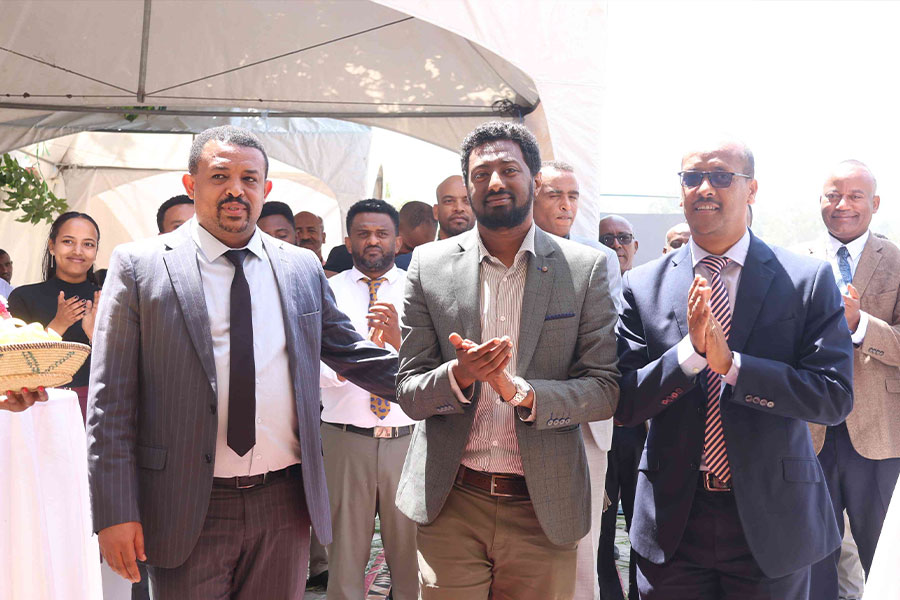
Radar | Sep 23,2023
Horra Adama Automotive Assembly Arena (H4A), a local vehicle assembler, has launched a new three-wheel model dubbed Maxima Z with an engine capacity of 236cc. The new model can be used for dual-purpose operations such as transporting passengers or cargo.
Launched last week, the model is assembled at the plant located in Adama, Oromia Regional State. The plant has a capacity of assembling 70 to 80 Maxima Z three-wheel models a day. Boasting an engine capacity of 236cc, the new model allows the passenger seating to be converted to cargo.
The plant was inaugurated in May 2018 with an investment of 1.5 billion Br. It assembles the three-wheel Maxima Bajaj, the four-wheel Qute Bajaj and the three-wheel Cargo Maxima Bajaj. It has a capacity of assembling 25,000 to 30,000 four-wheel and three-wheel Bajajs a year. The plant, which rests on 50,000Sqm of land located close to Belay Ab Motors plant in Adama, created employment opportunities for 150 individuals.
The automotive firm operates under the umbrella of Horra Group, which was established in 2005 and exports coffee, provides logistical services and engages in the real estate business. It operates Horra Real Estate, which is expected to start selling housing units this coming January, and Ethio Gabana, a specialty coffee company.
The company imports spare parts from India. A year and a half ago, it signed a memorandum of understanding (MoU) with Horizon Addis Tyre S.C., which was founded in 1972 as the first tyre production company in the country, to source the tyres.
"We're waiting to receive an approval from our supplier to use the locally-sourced tyres," Mintesinot Tezera, motor director at the company, told Fortune.
It plans to work in tandem with 250 dealers throughout the country to distribute its goods. The retail price tag for one Maxima Z model, whose engine operates on benzene, is set at 220,000 Br to 225,000 Br.
Before jumping into the assembly business, the company had been importing the three-wheel vehicles after signing a distribution agreement with Indian firm Bajaj Auto Ltd, the world's largest manufacturer and exporter of three-wheeled vehicles, in February 2015.
While building the plant, the company secured 35pc of the total budget from banks, including Abyssinia, Hibret, Awash, Debub Global, the Cooperative Bank of Oromia, as a loan that is set to be fully repaid in three to seven years, according to Adem Kedir, CEO and founder of Horra Trading Plc.
In addition to the banks, government organisations were a big help in getting the project off the ground, according to Adem.
The Oromia Investment Commission facilitated a land grant for the plant, and the Ethiopian Customs Commission offered bonded warehouse and tax incentives for the import of body and spare parts. The Chemical & Construction Inputs Industry Development Institute and the Construction Works Regulatory Authority also assisted the project, according to Adem.
The new model has brought a great advantage for consumers in its combined passenger and cargo functionality, according to Tsegaye Teferi, an automotive engineering expert with 10 years of experience. He cited a lack of spare parts as a possible problem and running on benzene as a disadvantage when compared with other three-wheeler that operate on diesel, which has a lower price.
"The vehicle's centre of gravity is higher, which is good for roads, but higher ground clearance could also lead to more accidents," he added.
Most of the three-wheelers in the country have no more than a 205cc engine, and the 236cc [Maxima Z] engine is an upgrade. Still, it means that it will have higher fuel consumption and could be a disadvantage to the project, according to Tsegaye, who also teaches at Adama Science & Technology Institute.
Horra plans to begin producing body and spare parts for three-wheelers at its plant in Adama in the coming year. This project will take from six to eight months to finish, according to Adem.
"The warehouse is completed, the foreign currency has been authorised, and we're going to begin this project in six months," said Adem. "The project will also benefit when local steel manufacturers begin full capacity production," he added.
Leather for chairs will be sourced from local producers, and the entire vehicle body could be produced at the plant, he said.
"We could've begun this project earlier, but COVID-19 forced us to postpone," he said.
The total number of three-wheeled vehicles operating in Ethiopia is 88,015 as of June 2020, according to statistics from the Federal Transport Authority.
PUBLISHED ON
Nov 21,2020 [ VOL
21 , NO
1073]

Radar | Sep 23,2023

Radar | Apr 20,2019

Radar | Oct 17,2022

Fortune News | Oct 18,2025

Radar | Jul 20,2025

Fortune News | Nov 25,2023

Fortune News | Sep 19,2020

Radar | Jun 15,2025

Radar | Aug 18,2024

Radar | Jan 31,2021

Dec 22 , 2024 . By TIZITA SHEWAFERAW
Charged with transforming colossal state-owned enterprises into modern and competitiv...

Aug 18 , 2024 . By AKSAH ITALO
Although predictable Yonas Zerihun's job in the ride-hailing service is not immune to...

Jul 28 , 2024 . By TIZITA SHEWAFERAW
Unhabitual, perhaps too many, Samuel Gebreyohannes, 38, used to occasionally enjoy a couple of beers at breakfast. However, he recently swit...

Jul 13 , 2024 . By AKSAH ITALO
Investors who rely on tractors, trucks, and field vehicles for commuting, transporting commodities, and f...

Oct 25 , 2025
The regulatory machinery is on overdrive. In only two years, no fewer than 35 new pro...

Oct 18 , 2025
The political establishment, notably the ruling party and its top brass, has become p...

Oct 11 , 2025
Ladislas Farago, a roving Associated Press (AP) correspondent, arrived in Ethiopia in...

Oct 4 , 2025
Eyob Tekalegn (PhD) had been in the Governor's chair for only weeks when, on Septembe...